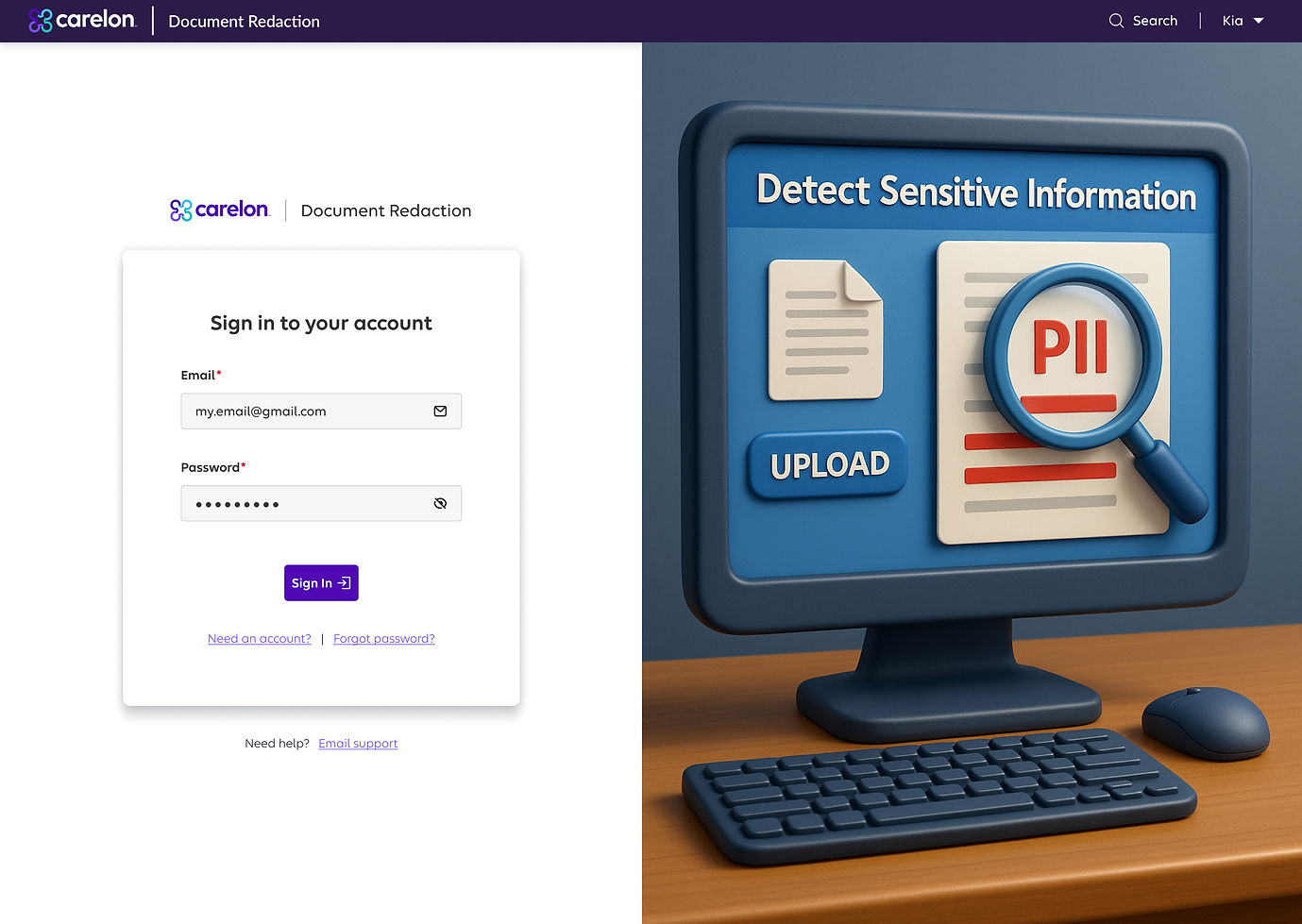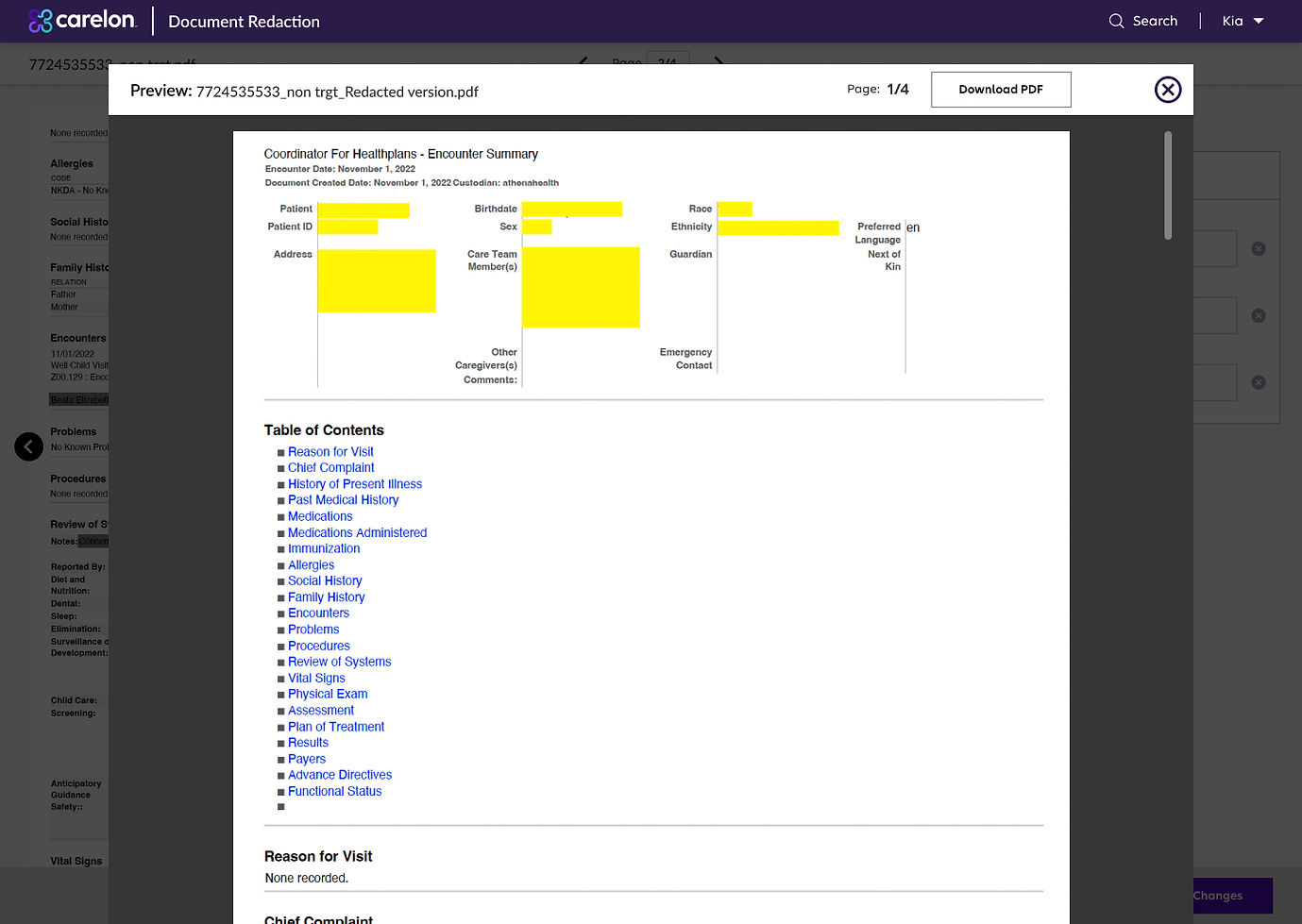PROBLEM STATEMENT
Design a tool to detect and redact sensitive information, such as Personally Identifiable Information (PII) and Protected Health Information (PHI), within uploaded documents.
Role
UX Design
Time
4 days
Team
Solo
Industry
Healthcare
Quick summary
HIGHLIGHTS
-
The current system used by internal employees lacks automation, making the process of identifying and masking sensitive data time-consuming and prone to human error.
-
Given that these documents are handled by multiple individuals, there is a need for a centralized tool to detect and redact sensitive information, such as Personally Identifiable Information (PII) and Protected Health Information (PHI), within uploaded documents and be made accessible to a designated group of users.
SOLUTION
-
A high level of User-Centered Design was practiced throughout the entire process. We eventually created a tool that is intuitive, clean, simple and automatically identifies sensitive data. It also gives an ability to manually masks specific data with zero defects.
-
Most importantly, the final product will optimize Carelon's capability of masking data and delivering documents.
RESULT
-
This POC was converted to a full time product utilized by the employees at Carelon.
-
Reduced time spent by 43%. Reduced errors while identifying data by 23%.
Before I move ahead...
Some assumptions, challenges, constraints and thoughts.
1. This is a proof of concept(POC).
2. It's a product that is not available in the organisation at the moment. Currently the employees use adobe acrobat to redact data manually which consumes a lot of time.
3. This POC had to be delivered in 4 business days.
Timeline
Communication is KEY
Working with a great team consisting of a product manager, a developer and a scrum master always ensures amazing outcomes - communication from start to finish was always smooth for this team. Right after the kickoff meeting, I delegated the work evenly to make sure we optimize our strengths yet we are all involved and are contributing in every single phase of the design process.

DISCOVERY
Understanding the needs and competitive study
-
Understanding the requirements/ functions of this tool
-
Technology constraints
-
What users want?
-
What users need?
-
Conducted workshop to understand the business needs and expectations
-
What is popular in the market?
Competitive products

While designing a tool for internal employees to identify and mask sensitive data, we explored its usability and existing features. Simultaneously, we analyzed leading masking tools in the market, identifying common strengths:
-
Clean Design: Interfaces are uncluttered and free of distractions.
-
Ease of Use: Intuitive navigation and context menus provide straightforward options based on selected elements.
-
Advanced Functionality: Accurate masking algorithms minimize data leakage risks, and collaborative features enable teams to work on documents simultaneously.
DEFINE
User persona
We started prioritizing and segregating areas to work on and form a strategy.
-
Understand key pain-points, wants and needs
-
Classify all insights gathered
-
User persona
Identified the primary persona
A user who can review and redact sensitive information before exporting the finalized document.

User flow
Based on the persona we created, I worked and identified the route, the most critical tasks that deliver the most value to the users on the product.

Site map
Site mapping is always important - it gives designers a bird's eye view of the product, it shows how pages are prioritized, linked, and labeled. The team worked together to pan out the sitemap based on the user flows.

IDEATE
Paper sketch
-
From the ideations presented to Product Manager and the business team, key ideas emerged:
-
Allow users to create a workspace using a split-screen approach, enabling them to review the document on one side and AI identifies the PHI/PII data that can be masked on the other.
-
A proposed layout was created and shared with users for feedback.

First iteration samples
We reviewed everything we had created so far - persona, user flows, and sitemap before we started.
The rest of the team was highly involved, too, during this stage. We communicated efficiently throughout, it was a "wireframe > iterate > re-wireframe" type of process.
Together, we went through 3 rounds of iterations by the end of this stage before the wireframes were approved.




THE UI
Revised iteration samples
I followed our companies own Carelon Style Guide. We had to make sure that all UI elements could work with the Carelon system, aesthetically and functionally. Margins, gutters, spacing, fonts & sizes - everything needed to be in line with the components kit.
The annotations made it easy to communicate with the stakeholders and the developer on how the developing process was going to go.





Visual designs were delivered to get the POC approved for budget.
The POC was approved and transformed into a full fledged project. Unfortunately it got transferred to another team as I was assigned another high priority project.
Review and reflections
Communicate! Communicate! Communicate!
There is nothing more important than communication for any project. Communicate with teammates, communicate with stakeholders/clients, communicate with developers - constant and smooth communication is the key to a great end-product.
Annotation is another way of Communication!
Great annotations throughout the design process is just as important as great communication - it makes possible for everybody to be on the same page without guessing or assuming how something would work. Annotate more always helps.